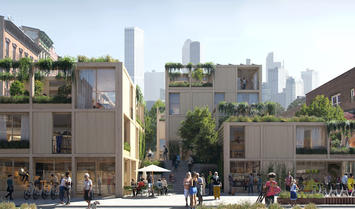
Anyone who's been in the urbanism game as long as I have (or longer) is probably familiar with the annual Places Rated Almanac, the annual metro area ranking reference produced by David Savageau. First published in 1981, I remember seeing each year's edition in bookstores while I was in high school and college, and it was the first attempt I could remember at evaluating the positives and negatives of place, and ranking them accordingly. It was the reference book I used to make the decision to choose the Bay Area for relocation after college in the mid-80s. (That never happened.)
One thing that always stuck out to me is how skewed the Place Rated rankings were toward new, smaller and suburban-oriented metros over older, larger and far more urban ones. In the early days New York and Boston ranked as lowly as Cleveland and Milwaukee; high crime rates and poor economies in each pulled their rankings down compared to Atlanta and Charlotte. It was then that I began thinking that big-city amenities would eventually count for something and turn the tide.
Over the years how we evaluate and measure metro area success has changed, as our metro areas have changed. As cities have rebounded, their cultural and social amenities play a more prominent role in how we evaluate them. As our economy morphed over the last 40 years from manufacturing-based to service and tech oriented, our measures of success changed with them. As gaps widen between the haves and have-nots in metro areas, we pay more attention to the breadth and depth of economic growth than we used to. But we're still prone to mischaracterizations based on incomplete data or old assumptions.
People like me, a Rust Belt native, have been looking for ways to compare our metros with others nationally, despite the demographic decline built into the system. Richey Piiparinen, director of urban theory and analytics at the Maxine Goodman Levin College of Urban Affairs at Cleveland State University, and principal and CEO at Rust Belt Analytica, wrote about this last January:
"In terms of population growth, the Sun Belt shines. Looking at the United States' largest 40 metros, the top seven fastest-growing from 2001 to 2017 are all in the Sun Belt: Austin (60.1%), Las Vegas (50.9%), Orlando (46.7%), Houston (43.1%), Charlotte (42.7%), San Antonio (41.5%) and Phoenix (40.8%). The bottom seven? They are all in the Rust Belt: Cleveland (-3.9%), Pittsburgh (-3.5%), Detroit (-3.3%), Providence (1.6%), Chicago (4.0%), St. Louis (4.4%) and Milwaukee (4.6%).
Peeling the onion back a bit reveals another narrative, however. In 2001, inflation-adjusted GDP per capita — a standard measure of labor productivity — was higher in the Sun Belt ($48,189) than the Rust Belt ($47,628). But that's no longer the case. The Rust Belt's GDP per capita is $54,435, compared to $52,419 in the Sun Belt. Looking at the growth rate since the Great Recession shows the Rust Belt pulling away, with gains of 13.1%, compared to 8.9% for the Sun Belt since 2009. Makes you wonder how much of the Sun Belt's labor productivity was contrived by the housing bubble.
A similar story unfolds when measuring real per capita income. The inflation-adjusted real per capita income is $52,939 in the Rust Belt, nearly $7,000 more than in the Sun Belt ($46,049). Again, the divergence has only gotten larger since the Great Recession.
We can keep going. The Rust Belt cities have more college-educated adults (5,956,549) than their Sun Belt counterparts (5,249,355), according to the 2018 Census. They also have higher college educational attainment rates (35.5% versus 33.0%). The Rust Belt has more workers with advanced degrees (2.03 million versus 1.39 million), as noted by the Current Population Survey. It also has a much greater concentration of skilled immigrants, with 34.2% of the Rust Belt's immigrants being college educated, compared to 27.9% in the Sun Belt. Oh, and when it comes to efficacy in land use, it's not even close. The Rust Belt's population density of 905 people per square mile is nearly double that of the Sun Belt (549).
So, on some of the most basic measures of development — productivity, prosperity, education, density — it's the Rust Belt that's on top. This reality echoes Richard Florida's analysis that population growth "bears little relation to economic growth, and it's a terribly misleading indicator of it.""
The Brookings Institute's Metro Monitor seeks to expand our notion of metro success. For several years Brookings has been measuring the economic performance of metros, yet also examining it in the context of the depth and breadth of its economy. Brookings started by evaluating the breadth and depth of global cities, but in the last few years they've focused exclusively on American metros. Now they gather and analyze data on the 192 largest metros in the U.S., or those with a population of 250,000 or more. Together, Brookings estimates the 192 largest metros hold 77% of the nation's population and generate 85% of the nation's gross domestic product.
Read the rest of this piece at Corner Side Yard blog.
Pete Saunders is a writer and researcher whose work focuses on urbanism and public policy. Pete has been the editor/publisher of the Corner Side Yard, an urbanist blog, since 2012. Pete is also an urban affairs contributor to Forbes Magazine’s online platform. Pete’s writings have been published widely in traditional and internet media outlets, including the feature article in the December 2018 issue of Planning Magazine. Pete has more than twenty years’ experience in planning, economic development, and community development, with stops in the public, private and non-profit sectors. He lives in Chicago.
Photo credit: archdaily.com












